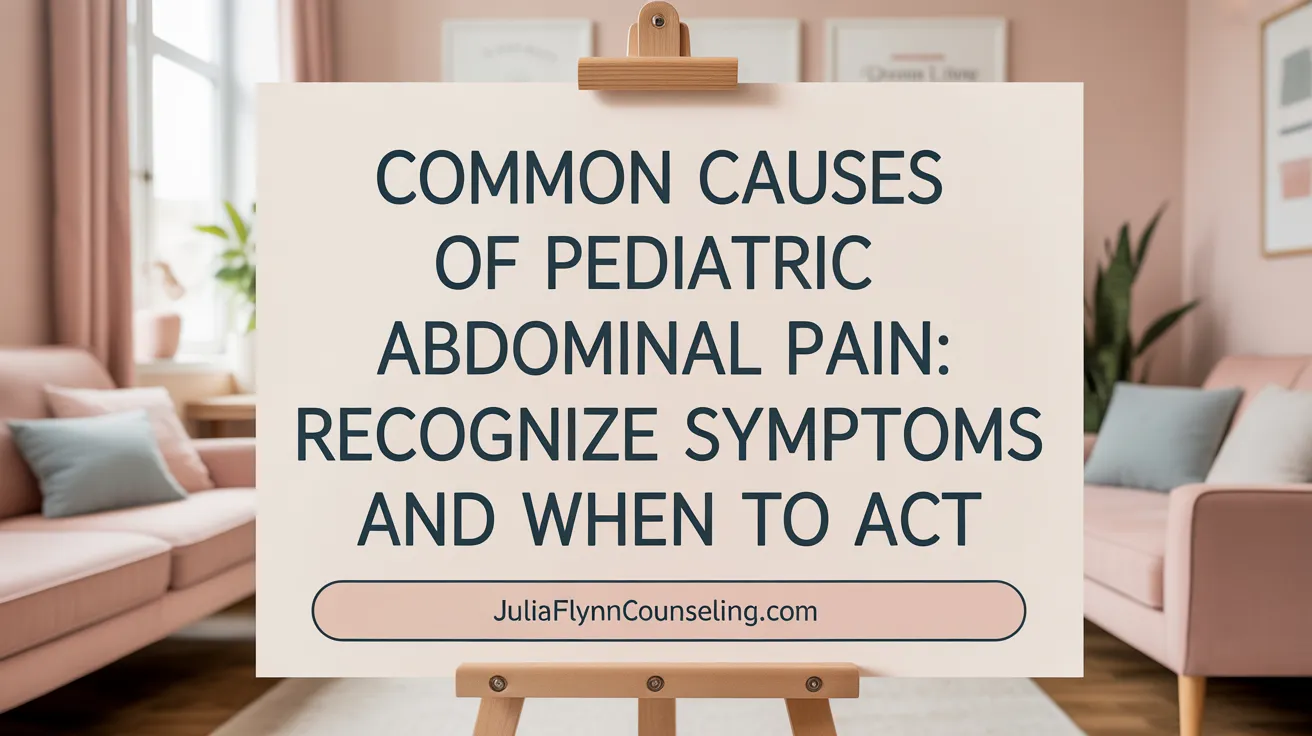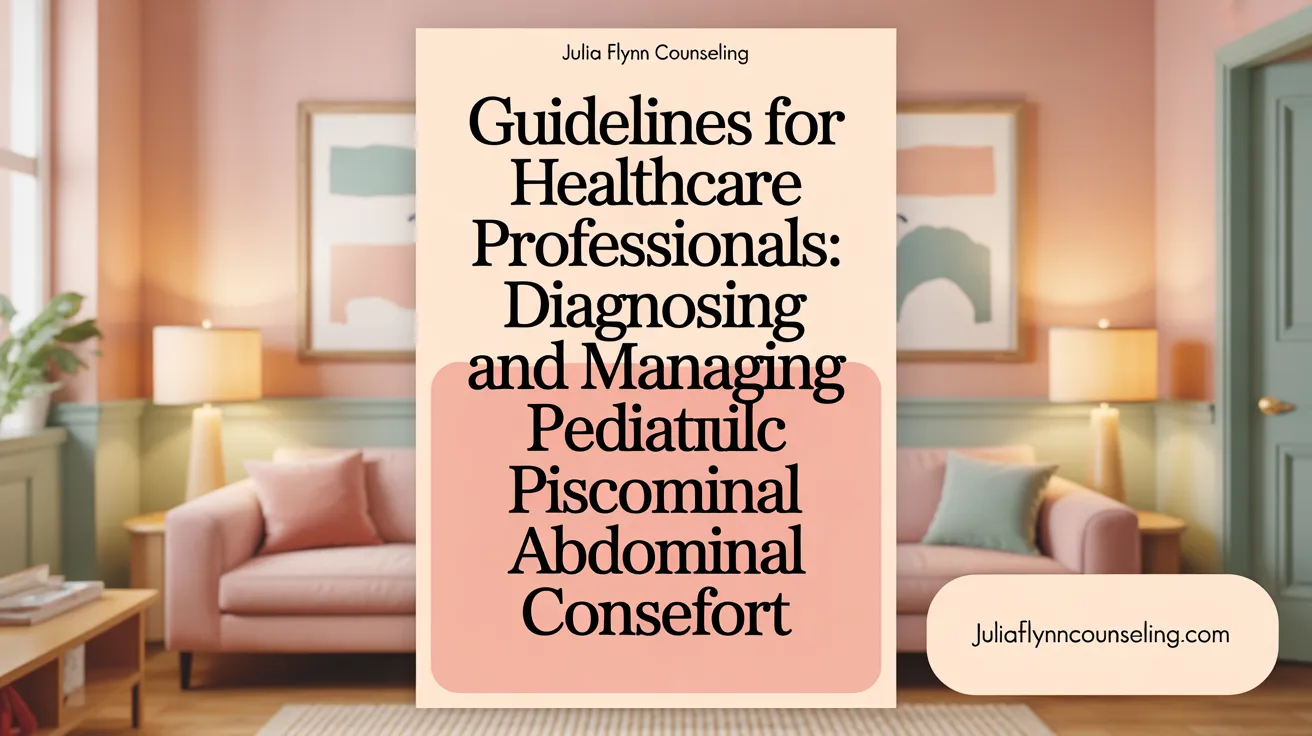Understanding Pediatric Abdominal Pain
Abdominal pain is a frequent and challenging complaint in pediatric care, representing nearly 9% of childhood visits in primary care and accounting for 10% of emergency department visits. Causes range from benign, self-limited conditions to urgent surgical emergencies. Distinguishing between these requires careful evaluation, timely diagnosis, and appropriate management. This article addresses the multifaceted nature of abdominal pain in children, focusing on clinical features, diagnostic strategies, common conditions including functional abdominal pain, and best practices for healthcare professionals and caregivers alike. It aims to empower readers with knowledge to recognize symptoms, understand diagnostic protocols, and respond effectively to this common pediatric health issue.
Common Causes and Symptomatology of Pediatric Abdominal Pain

What are common causes of abdominal pain in children?
In children, abdominal pain can result from a wide variety of conditions, ranging from benign to potentially serious. Typical benign causes include constipation, which often presents with pain linked to bowel movements or fullness; gastrointestinal infections such as rotavirus or norovirus, which may cause cramps, diarrhea, and vomiting; food allergies or intolerance, like lactose intolerance, leading to bloating and pain after eating certain foods; and abdominal migraines, characterized by episodic pain without detectable structural abnormalities.
Serious causes, however, demand prompt attention. These include appendicitis, which often causes localized pain in the right lower quadrant and may be associated with fever and vomiting; bowel obstruction, which presents with colicky, severe pain, distension, and vomiting; gallstones causing right upper quadrant pain; urinary tract infections with lower abdominal or flank pain; inflammatory bowel disease presenting with chronic pain, diarrhea, and weight loss. Additional causes encompass hernias, ovarian or testicular torsion, ingestion of foreign objects, and trauma.
Distinguishing between benign and serious causes involves assessing the pain characteristics, associated symptoms, and physical examination findings. Persistent pain lasting more than 24 hours, worsening symptoms, or the presence of blood in stool, high fever, or signs of systemic illness necessitate urgent medical evaluation.
Diagnostic Approach and Differential Diagnosis of Pediatric Abdominal Pain
How is abdominal pain in pediatric patients diagnosed and what are the differential diagnoses?
Diagnosing abdominal pain in children involves a detailed approach starting with a comprehensive history and physical examination. Clinicians look for specific features such as pain location, onset, duration, character, and associated symptoms like nausea, vomiting, diarrhea, or urinary complaints. Identifying alarm signs—such as blood in stool, persistent vomiting, or a rigid abdomen—helps determine the urgency.
Laboratory tests play a vital role. A complete blood count (CBC) can reveal signs of infection or inflammation. Inflammatory markers like ESR or CRP further support suspicion of infectious or inflammatory diseases. Urinalysis helps identify urinary tract infections, while a pregnancy test is essential in adolescent girls to exclude ectopic pregnancy.
Imaging begins with ultrasonography, the preferred first-line modality due to its safety and effectiveness, especially for conditions like appendicitis or ovarian torsion. When ultrasound findings are inconclusive and clinical suspicion persists, particularly for appendicitis, a computed tomography (CT) scan may be considered. However, radiation exposure should be minimized, reserving CT for select cases.
The differential diagnoses in pediatric abdominal pain are broad. Common surgical causes include appendicitis, intussusception, mesenteric lymphadenitis, bowel obstruction, volvulus, and Meckel’s diverticulum. Non-surgical causes span constipation, gastroenteritis, ovarian torsion, ectopic pregnancy, urinary tract infection, inflammatory bowel diseases, and functional disorders like irritable bowel syndrome.
Timely and accurate diagnosis relies on correlating clinical features with laboratory and imaging results. Recognizing signs suggestive of surgical emergencies is crucial for prompt intervention, while benign, functional causes often resolve with reassurance and symptomatic care.
Clinical Guidelines and Best Practices for Healthcare Professionals

What clinical guidelines and best practices should healthcare professionals follow when managing abdominal pain in pediatric patients?
Managing abdominal pain in children requires a systematic and cautious approach. Healthcare providers should begin with a careful assessment of the child's condition, focusing on the severity and nature of symptoms. It is crucial to look for signs indicating potential surgical emergencies, such as rebound tenderness, rigidity, absent bowel sounds, bloody stool, and high fever.
Initial investigations are guided by clinical suspicion. Routine tests like urinalysis, complete blood count, and inflammatory markers like ESR or CRP help identify infections or inflammatory processes. Abdominal ultrasonography is the imaging modality of choice for evaluating most cases, especially for conditions like appendicitis or intussusception. Computed tomography scans are reserved for specific cases when ultrasonography results are inconclusive or when detailed visualization is necessary, particularly in suspected appendicitis.
When children present with recurrent or chronic abdominal pain without alarm signs, diagnosis primarily relies on clinical evaluation using the Rome IV criteria to identify functional gastrointestinal disorders, including irritable bowel syndrome (IBS) and dyspepsia. Reassurance and education are vital, as most cases are benign.
Pain management should be patient-centered. The judicious use of analgesics, including opioids, can be necessary for adequate pain control and to facilitate thorough physical examinations. Importantly, opioids should be used responsibly to avoid masking signs that could indicate worsening pathology, and they should not delay definitive diagnosis or intervention.
Psychological therapies such as cognitive-behavioral therapy, hypnotherapy, and relaxation techniques can be effective in managing functional abdominal pain. Addressing psychosocial factors—including stress, anxiety, and emotional trauma—is fundamental.
Re-evaluation and ongoing monitoring are essential components of management. Healthcare professionals should closely watch for any signs of deterioration or new symptoms that could indicate a progression of underlying disease, prompting further investigation or surgical consultation.
In summary, clinical management should prioritize patient safety, apply evidence-based diagnostic strategies, incorporate appropriate pain control, and support the child's and family’s psychological well-being to optimize outcomes.
Management and Treatment Strategies for Pediatric Abdominal Pain

What are effective treatment and management strategies for abdominal pain in children?
Managing abdominal pain in children requires an organized approach to distinguish between benign and serious causes. Initially, a detailed history and physical examination are essential. Assessing the pain’s location, onset, duration, and accompanying symptoms helps identify potential surgical causes such as appendicitis, intussusception, or volvulus.
Most children with abdominal pain have self-limited, benign conditions. Supportive care—including rest, hydration with clear fluids, and symptomatic relief—is often sufficient. Providing reassurance about the generally benign nature of the pain is crucial for alleviating parental anxiety.
Pain control plays a vital role in management. Opiates, when used carefully, can be effective to reduce discomfort and improve examination quality, aiding in accurate diagnosis. These medications should be administered under supervision, with monitoring for side effects.
Laboratory tests like complete blood count and urinalysis, along with imaging such as ultrasonography, help identify causes requiring surgical intervention, like appendicitis. If signs of severe illness or peritonitis are present, urgent surgical consultation and possible operative management are indicated.
In cases where no surgical pathology is found, treatment focuses on addressing symptoms and providing supportive care. This might include dietary modifications—such as avoiding greasy, spicy, or gas-forming foods—and medications like anti-spasmodics or laxatives if bowel motility is affected.
For functional abdominal pain, which is common, psychological and behavioral interventions are effective. Approaches like cognitive-behavioral therapy, relaxation exercises, biofeedback, and hypnotherapy can help children cope better with their symptoms.
Follow-up and serial reevaluation are essential, especially in nonurgent cases. Monitoring progression ensures that any worsening symptoms are promptly identified. Overall, a patient-centered, multidisciplinary approach combining medical, psychological, and supportive therapies offers the best outcomes for children with abdominal pain.
Understanding Functional Abdominal Pain in Children

What is functional abdominal pain in children and how is it different from other types of abdominal pain?
Functional abdominal pain (FAP) in children refers to recurring or ongoing stomach discomfort that cannot be linked to any physical abnormality, structural issue, or biochemical disorder after comprehensive evaluation. Unlike pain caused by infections, inflammation, or organ-specific conditions, FAP often presents with normal physical examinations and test results.
Children with FAP typically experience pain that has no clear relation to food intake, physical activity, or bowel movements. The pain can be episodic or continuous and often occurs around the navel, though its intensity can vary.
The underlying cause is believed to involve increased sensitivity of the nerves in the gut, leading to an exaggerated perception of normal gut sensations. Emotional stress, anxiety, and other psychological factors may play significant roles.
While organic causes like infections, appendicitis, or inflammatory bowel disease require specific treatments, FAP management centers on reassurance, psychological support, dietary modifications, and sometimes behavioral therapies.
Understanding the distinction between functional and organic abdominal pain helps avoid unnecessary tests and allows for targeted, supportive care to improve the child's quality of life.
Specific Considerations for Acute Versus Chronic Abdominal Pain
What are the specific considerations for chronic versus acute abdominal pain in children?
When evaluating abdominal pain in children, distinguishing between acute and chronic presentations is crucial because they often require different approaches to diagnosis and management.
Acute abdominal pain, characterized by rapid onset and often severe symptoms, frequently stems from conditions like appendicitis, gastroenteritis, bowel obstruction, or intussusception. These conditions may need urgent assessment and intervention to prevent complications. Signs such as rigid abdomen, rebound tenderness, or sudden severe pain heighten suspicion for surgical emergencies.
In contrast, chronic or recurrent abdominal pain lasts for more than two weeks and is often benign. It is frequently functional, meaning no structural or biochemical abnormalities are found. Common causes include irritable bowel syndrome, constipation, food intolerances, or gut-brain axis dysfunction.
In children with chronic pain, a thorough history and physical exam help identify alarm features that suggest organic disease, such as blood in stool, unexplained weight loss, or persistent vomiting. These features warrant further investigations.
Overall, the key differences lie in the duration of symptoms, associated features, and severity. While acute pain demands quick action to rule out life-threatening conditions, chronic pain management focuses on supportive care and addressing underlying psychological or functional factors.
Hence, clinical judgment based on these distinctions guides whether children need immediate surgical evaluation or a more conservative, multidisciplinary approach aimed at improving quality of life.
When to Seek Medical Attention: Guidance for Parents and Caregivers
Parents and caregivers must be vigilant in recognizing signs that indicate the need for urgent medical care in children presenting with abdominal pain. If a child experiences sudden, severe pain, or pain that lasts longer than one hour, prompt evaluation is necessary because these symptoms may point to serious conditions such as appendicitis or bowel obstruction. Other warning signs include high fever, persistent vomiting, blood in stool or vomit, signs of dehydration like dry mouth or sunken eyes, and a rigid or extremely tender abdomen.
Special attention should be given to infants, particularly those under 12 weeks, who show symptoms such as persistent crying, feeding difficulties, or abdominal distention. These signs can be indicative of life-threatening conditions that require immediate medical attention.
It is also important to seek care quickly if the child’s pain is worsening, does not improve, or is associated with additional alarming symptoms. These include difficulty breathing, loss of consciousness, pale or mottled skin, or ongoing pain that interferes with daily activities.
Early assessment by healthcare professionals allows for timely diagnosis and treatment, reducing the risk of complications. In cases of concern, the guiding principle is: when in doubt, seek emergency medical help to ensure the child’s safety and well-being.
Comprehensive Care Models and Emerging Paradigms in Pediatric Abdominal Pain

Integrated multidisciplinary programs combining gastroenterology and psychology
Recent advances in pediatric abdominal pain management have emphasized the importance of integrated treatment approaches. Specialized programs like the Pediatric Abdominal Pain Program at Children’s Mercy exemplify this model by combining gastroenterology and psychological care within a single clinic visit. These programs assess biological, psychological, and social factors simultaneously, allowing for comprehensive evaluation and personalized treatment plans.
Such collaboration improves diagnostic accuracy, especially in complex cases of recurrent or chronic abdominal pain where multifactorial causes are suspected. It also facilitates early identification of psychological contributors, such as anxiety or stress, which might exacerbate gastrointestinal symptoms.
Biopsychosocial approach to chronic and functional abdominal pain
A shift from solely biomedical models to a biopsychosocial perspective marks a new paradigm in treating pediatric abdominal pain. This approach recognizes that symptoms often stem from a confluence of physical, emotional, and environmental factors.
In cases of functional abdominal pain, which lack identifiable structural abnormalities, psychosocial elements like emotional distress significantly influence symptom severity. Managing these cases involves reassurance, psychological therapies, and lifestyle modifications, aiming to improve overall quality of life rather than just symptom elimination.
Role of behavioral therapies and mind-body practices
Behavioral therapies such as cognitive-behavioral therapy (CBT), hypnotherapy, and biofeedback have demonstrated effectiveness. These modalities help children develop coping skills, reduce pain perception, and manage stress.
Mind-body practices, including relaxation techniques and guided imagery, have shown promise in reducing the intensity and frequency of pain episodes. Incorporating these therapies into standard care protocols can decrease reliance on medications and enhance resilience.
Supportive care emphasizing quality of life and family education
Educating families about the benign and often self-limited nature of most pediatric abdominal pain fosters reassurance and reduces anxiety. Supportive care focuses on maintaining normal activities, proper nutrition, and psychological well-being.
Effective communication involves validating the child's pain experience while explaining the non-organic nature of functional pains. Providing resources for mental health support and pain management empowers families and promotes adherence to treatment plans.
Research-driven advances in diagnosis and treatment
Emerging research continues to refine diagnostic criteria, such as the Rome IV for functional gastrointestinal disorders, enabling accurate identification without extensive testing. Advances include the use of non-invasive tools and biomarkers to differentiate organic from functional conditions.
Additionally, ongoing studies explore novel therapies, including probiotics, dietary interventions, and neuromodulators like low-dose antidepressants, tailored to the individual patient’s profile. These innovations promise more effective and personalized treatment strategies in the future.
| Aspect | Approach | Benefits | Details |
|---|---|---|---|
| Program Model | Multidisciplinary teams | Comprehensive care | Combining gastroenterology and psychology in one program |
| Treatment Philosophy | Biopsychosocial | Holistic management | Addresses physical, emotional, and social influences |
| Therapeutic Modalities | Behavioral therapies, mind-body practices | Pain reduction and coping | CBT, hypnotherapy, relaxation techniques |
| Family Role | Education and reassurance | Improved adherence and reduced anxiety | Clear communication, resource provision |
| Research Focus | Diagnostic criteria, personalized treatments | Better outcomes | From Rome IV to novel medications |
This evolving landscape underscores a future where pediatric abdominal pain is addressed holistically, combining scientific advances with compassionate care to enhance the well-being of young patients.
Empowering Care Through Knowledge and Collaboration
Abdominal pain in pediatric patients challenges caregivers and healthcare professionals alike due to its broad spectrum of causes and presentations. Understanding common etiologies, recognizing critical symptoms, and following systematic evaluation protocols are vital to timely diagnosis and management. Functional abdominal pain, while common and often benign, requires sensitive, multidisciplinary approaches that address the complex gut-brain interactions and psychological factors influencing symptoms. Parents and clinicians should work collaboratively, with open communication and education, to improve outcomes and quality of life for children experiencing abdominal pain. Continued research and integrated care models promise to further advance and personalize management strategies.
References
- Acute Abdominal Pain in Children - AAFP
- Functional Abdominal Pain in Children | ACG
- Acute Abdominal Pain in Children - AAFP
- Abdominal pain - children under age 12 - MedlinePlus
- Managing acute abdominal pain in pediatric patients
- Chronic Abdominal Pain | Children's Hospital Colorado
- Managing Pediatric Lower Abdominal Pain: Symptoms, Causes, and ...
